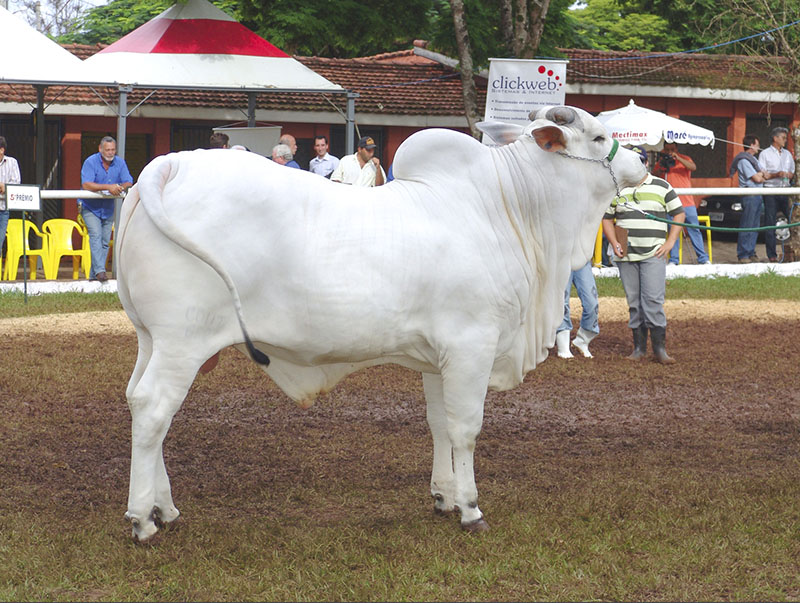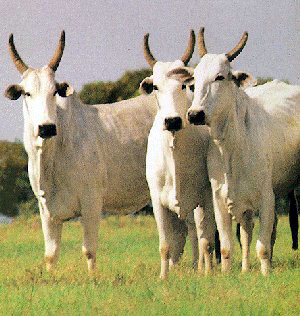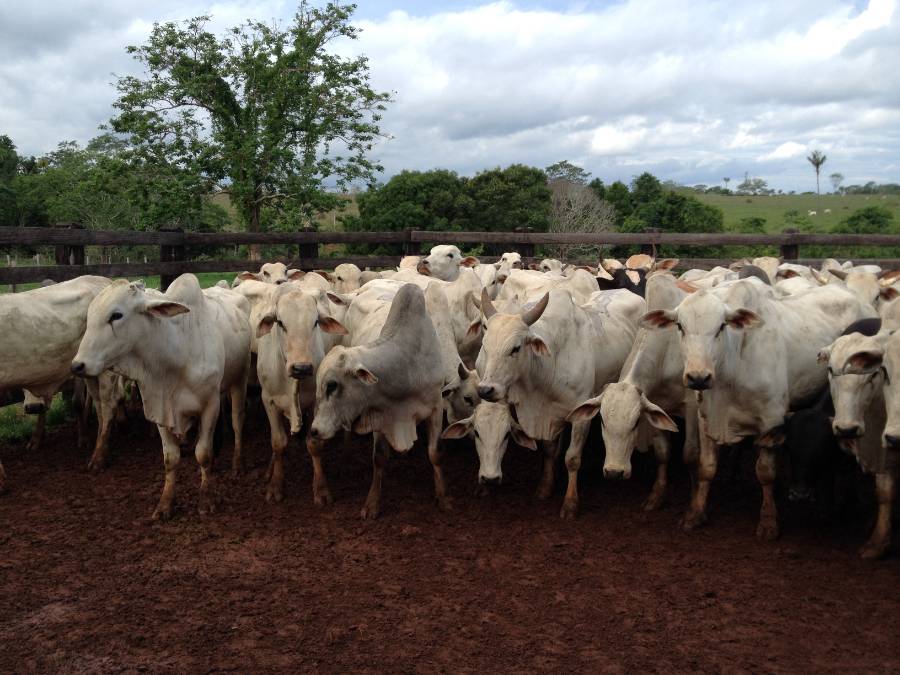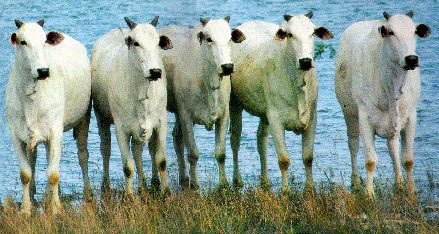Nelore Cattle
The Nelore is of the species Bos indicus (Zebu),  and has great dissimilarities to breeds of the Bos taurus (European) species, like the Angus, Hereford, Charolaisand others. Their most distinctive characteristic is the presence of a prominent “hump”
behind their neck, but there are many other fundamental differences between the Nelore
and the European breeds.
and has great dissimilarities to breeds of the Bos taurus (European) species, like the Angus, Hereford, Charolaisand others. Their most distinctive characteristic is the presence of a prominent “hump”
behind their neck, but there are many other fundamental differences between the Nelore
and the European breeds.
There has never existed in India a breed called Nelore. This name corresponds to a district of the old Presidency of Madrás, now belonging to the new State of Andra, by the Bengal Sea. It was in Brazil that some authors started to use the name Nellore as a synonym to Ongole, the Indian breed that contributed most to the creation of the Nelore. The history of the Ongole dates back 2,000 years before Christian times. It was the Aryan people that brought the ancestors of the Nelore to India, where they were submitted to extreme weather conditions. The arid lands of Belushistan, the cold winters of Punjab, the alluvial lands of Ganges and the torrid lands by the Bengal sea provided the Ongole breed with the adaptation genes that are now favorably expressed in the modern Nelore.
Brazil has become the largest breeder of Nelore, and from there the breed was exported to Argentina, Paraguay, Venezuela, Central America, Mexico, United States and many other countries. In all those places, the contribution of the Nelore was remarkable, whether through purebred selection within the breed or through crosses with local breeds, many times of European origin.
 The Nelore was first acknowledged in Brazil in 1868, when a ship on its way to England
carrying two Ongoles stopped in Salvador, Bahia, and the animals were there sold.
Ten years later, a breeder from Rio de Janeiro, named Manoel Ubelhart Lemgruber, bought
another couple from the Hamburg Zoo in Germany. Then the Nelore breed expanded gradually,
first in Rio de Janeiro and Bahia, then in Minas Gerais, having reached Uberaba in
1875.
The Nelore was first acknowledged in Brazil in 1868, when a ship on its way to England
carrying two Ongoles stopped in Salvador, Bahia, and the animals were there sold.
Ten years later, a breeder from Rio de Janeiro, named Manoel Ubelhart Lemgruber, bought
another couple from the Hamburg Zoo in Germany. Then the Nelore breed expanded gradually,
first in Rio de Janeiro and Bahia, then in Minas Gerais, having reached Uberaba in
1875.
The creation of the Nelore Herd Book and the definition of the breed standards in Uberaba, 1938, was of great relevance in the formation of the Nelore. In 1960, 20 animals were imported, and in 1962, the last and most relevant purchase of live animals from India authorized by the Brazilian Government, 84 Ongoles were imported. These became founders of important breeding lines like Godahvari, Karvadi and Taj Mahal, and were decisive to the great expansion of the Brazilian herd in the last 30 years, going from 56 million in 1965 to 160 million in 1995, 100 million of which are Nelore.
Distinguishing Characteristics
It is said that there is no ideal breed, and that every breed has strong points and none is better for all important economic traits, the Nelore is certainly the best alternative for economic beef production in the tropics, which are responsible for 65% of the world’s bovine population.
- Hardiness. The main advantage that the Nelore has over other breeds of beef cattle is its hardiness. Calves are alert, with an active behavior, standing up and suckling soon after they are born, without any need for constant human intervention. The Nelore has notable physical strength and is unexcelled in its ability to thrive under harsh climatic, nutritional and sanitary conditions, frequent in the tropics. Because of their hardiness and rustling ability, Nelores surpass all other breeds under conditions of poor range and drought.
- Heat and Insect Resistance. The Nelore has a loose skin with sweat glands that are twice as big and 30% more numerous than those of the European breeds. The Nelore’s black skin, covered by a white or light gray coat helps filtering and reflecting harmful sun rays. Its low level of metabolism also contributes to heat resistance, as the Nelore feeds less but often, generating less internal heat. Nelores possess natural resistance to various insects, as its skin has a dense texture, making it difficult for blood sucking insects to penetrate. Nelores also have a well developed subcutaneous muscle layer which enables them to remove insects simply by shaking their coat.
- Metabolic Efficiency. The Nelore can efficiently convert poor quality forages into beef, and withstand long periods without water. Due to their habit of feeding lightly but frequently, Nelore and Nelore hybrid cattle are highly resistant to bloating, and death losses rarely occur from this cause. Excellent feed conversion ratio and good disposition allow the Nelore to be early finished in feedlots, with highly positive results.
- Meat Quality. While the beef of some breeds have excessive marbling, or intra-muscular fat, beef from Nelore cattle have enough fat to be highly palatable. The Nelore matches the recent shift in the beef industry towards a low calorie, leaner meat diet, without compromising taste. This was demonstrated at the 1991 Houston Livestock Show and Rodeo, when a purebred Nelore steer won the “Best Overall in Taste” contest, competing against dozens of hybrid and European steers.
- Reproductive Efficiency. Nelores have long, deep bodies with clear underlines, keeping vulnerable parts out of the way of infection. Cows have small udders and short teats, while bulls' sheaths are also short. These characteristics contribute to the breed’s reproductive efficiency. Nelore dams have a long and prolific reproductive life, pronounced mothering ability, and plenty of milk for their calves. The Nelore cows calve very easily due to their greater frame, wide pelvic opening and larger birth canal, which reduces the incidence of distocia.
- Maternal Instinct and Disposition. Nelore dams have highly developed maternal instinct throughout the whole milking period, which is of great importance for extensive breeding systems. They lick their newborn, put them to suckle and look for a safe place to hide them from predators. The active and vivid disposition of the Nelore is largely responsible for their unusual thriftiness, hardiness and adaptability to a wide range of feed and climate. Nelores like affection and quickly respond to kind handling methods, becoming extremely docile.
Selection
A lot of genetic variation exists among all breeds, and the selection within a breed is almost as important as the choice of the breed itself. Generation after generation, during thousands of years favoring the survival of the strongest and better prepared to withstand the intense heat, the lack of forages, the prolonged dry season and the many diseases has shaped anatomically and physiologically the ancestors of the modern Nelore with a common denominator: hardiness, fertility and longevity.
Once in Brazil, this natural selection base was then managed and redirected for beef production. The result was encouraging. In a few decades, the Brazilian Nelore became an impressive biotype in terms of uniformity, conformation and quality, still preserving the attributes of hardiness and vivid disposition. Once the ethnic purity was consolidated, the Brazilian Nelore breeders have been selected for body size and muscular development, as well as skeletal soundness.
Each and every registered Nelore sire is the outcome of a complex process of selection. Breeders receive assistance from a nationwide association, the Assoc
iação Brasileira dos Criadores de Zebu or ABCZ. Birth weight, weaning weight, yearling weight, scrotal circumference, are some of the traits measured. Research centers and universities calculate EPDs (Expected Progeny Difference) through complex mathematical models and powerful super-computers, making the results available to breeders to support their selection decisions.

Figure 3. Image provided by Jose Lionel Velez
Genetics and Breeding
Today, the number of purebred registered Nelore is above 5 million. The challenge faced by selection is to multiply the genetic gains to a much larger population. To multiply the genetic potential of Nelore sires, Artificial Insemination is being used in large scale since the 60’s. Sales of Nelore semen represent 65% of the AI market of all beef breeds in Brazil. The leading Nelore sire there produced and sold 34,000 straws of semen in 1995, followed by another Nelore that sold 30,000, which means that both sires must have bred more than 20,000 cows.
Effort is also being made to multiply the genetic potential of Nelore dams through the use of embryo transfer. With more than 50,000 embryos transferred per year, a great part of which are Nelores, Brazil is already the 3rd country in this technology, after the United States and France. Work is also well under way with frozen embryos, embryo splitting and In Vitro Fertilization of Nelores.
The Polled Nelore
There is a worldwide tendency for the elimination of horns in all cattle breeds through the use of naturally polled animals. The advent of the Polled Nelore, some 50 years ago, has presented the beef cattle industry with an option to avoid the mechanical removal of horns, a common practice, especially in feedlots. This dehorning method is expensive, time consuming and painful for the animal, causing stress and weight loss, besides exposing the steers to various infections. If horns were necessary for defense purpose in a wild environment, today a naturally polled animal brings many advantages.
Management of polled herds is easy and friendly, as herds are more homogeneous and it is possible to gather more animals at one time in the corral or in a truck for transportation. The polled Nelore also presents less injuries from fights, preserving their coats for the leather industry. As a result of these advantages, the number of genetically polled steers in commercial herds is rapidly increasing.
Since the polled type is genetically dominant over the horned type, when a horned dam is bred to a polled sire or a polled dam is bred by a horned sire, approximately 85-90% of the offspring will be genetically polled. That is of great importance to the polled Nelore selection, as breeders have access to both the polled and the horned Nelore genetic banks. It also allows breeders of the horned type to easily start a polled herd simply by using a polled sire on their dams.
 Crossbreeding
Crossbreeding
There is a universal trend toward meat production through crossbreeding. Heterosis, or hybrid vigor, is the biological phenomenon in which the performance of the offspring is greater than the average of the parents. The more distantly related the parents are, the greater is the hybrid vigor response in their progeny. Classic scientists like Linneo and Darwin supported the idea of Bos Indicus (Nelore) and Bos Taurus (European) to be considered separate species due to the differences they presented from the adaptation to environments diametrically opposites in latitude. In beef cattle, maximum hybrid vigor results from crossbreeding these two historically unrelated species.
Hybrid vigor in beef cattle is expressed in heavier weaning weights, increased milk production, greater calf vitality, higher fertility and increased resistance to disease. In addition to increased weight for age and greater carcass efficiency, the hybrid animal inherits to a great extent many economic characteristics of its Nelore parent, such as drought resistance, heat tolerance, disease resistance and increased longevity.
Ina recent research done by the U.S. Meat Animal Research Center in Nebraska, the Nelore F1s showed the largest percentage of unassisted calving, the highest weaning percentage, and their offspring calves were 2nd in 200-day weaning weight of the 11 breeds evaluated. These results combined placed the Nelore F1s as the most productive dams, with an impressive 115.0 ratio.
U.S. MEAT ANIMAL RESEARCH CENTER - Clay Center, Nebraska
GERM PLASM EVALUATION PROGRAM - Cycle IV, Phase 3. Calves born 1988-89*
| Breed group of dam | Number of cows | % Calving unassisted | Birth weight, lb | % Calves weaned | 200 day weight , lb | lb weaned per 100 cows | Ratio % |
|---|---|---|---|---|---|---|---|
| Original HAx | 74 | 67.6 | 75.6 | 83 | 458.3 | 38,039 | 91.6 |
| Current HAx | 78 | 68.9 | 80.2 | 89 | 487.5 | 43,388 | 104.4 |
| Charolais | 60 | 72.9 | 83.0 | 76 | 498.7 | 37,901 | 91.2 |
| Gelbvieh | 68 | 70.7 | 78.7 | 79 | 507.7 | 40,108 | 96.5 |
| Pinzgauer | 72 | 64.0 | 82.4 | 81 | 508.1 | 41,156 | 99.1 |
| Shorthorn | 43 | 75.2 | 84.0 | 85 | 512.6 | 43,571 | 104.9 |
| Galloway | 67 | 74.9 | 74.1 | 80 | 449.2 | 35,936 | 86.5 |
| Longhorn | 70 | 86.0 | 74.9 | 89 | 464.2 | 41,314 | 99.4 |
| Nelore | 69 | 95.1 | 70.7 | 93 | 513.5 | 47,756 | 115.0 |
| Piedmontese | 78 | 64.6 | 79.2 | 88.0 | 491.9 | 43,287 | 104.2 |
| Salers | 58 | 85.7 | 82.5 | 85 | 523.9 | 44.532 | 107.2 |
* Data are for 560 F1 females exposed to Red Poll bulls to produce first calves at 2 years of age and for 312 F1 females exposed to Simmental bulls to produce their second calves at 3 years of age.
In the United States a common spelling for the breed is Nellore. When the Ongole breed was first imported from Andhra Pradesh to Brazil it was called "Nellore" after the district of origin. Soon the extra "L" was dropped since it is not necessary in Portuguese. Several authors now give Nellore as a synonym of the Ongole breed from India.
References
Correspondence, João Pedro Flecha De Lima, Rua Prof. Alexandre Correa, 591 - 4 and. 05657-230 Sao Paulo, SP - BRAZIL Email: jpflecha@amhost.amcham.com.br
Joshi, N.R., Phillips, R.W. (1953) Zebu Cattle of India and Pakistan, FAO Agriculture
Studies No. 19, Publ. by FAO, Rome, 256 pp.
Mason, I.L. World Dictionary of Livestock Breeds. Third Edition. C.A.B International. 1988
Correspondence, I.L. Mason, Edinburgh, Scotland
